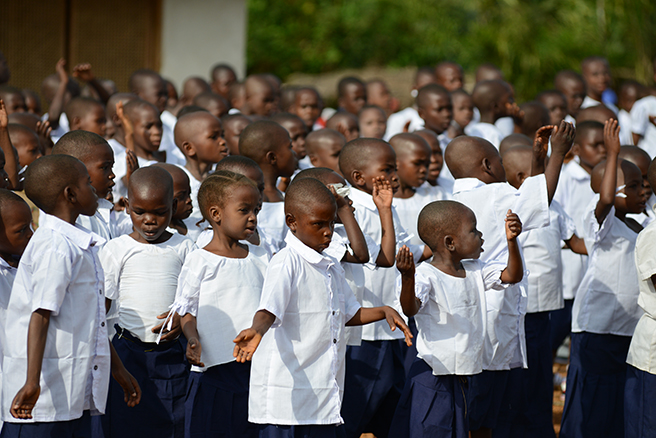Ilima, an Example to Follow

It goes without saying that emphasizing the link between education and conservation is not a fruitless endeavor. The desired outcome is a community which consciously chooses to look after its forest as a heritage for its children, its children’s children, and its children’s children’s children, who will all benefit from these efforts in turn.
In a less than perfect world where there exists, sadly, the issue of wildlife crime and a multi-billion dollar illegal wildlife trade impacting elephants, bonobos and other Congo species, it’s a relief to know that such an outcome really can happen! This is the story of Ilima (if you’ve missed an episode or two), the remote community in the territory of Befale, northeastern Democratic Republic of Congo (DRC). AWF has been working closely with this community on a special project for the past year and a half: Ilima Conservation Primary School.
365 days of the year, Ilima is a part of the world just a few degrees north of the equator, where the sun typically rises at around 5:30, and first light activities focus on collecting water from a nearby stream or brook. An hour later, self-enterprising mamas, who have finished sweeping the communal courtyards to their homes, are now stationed along the large trail running through the village, dropping tablespoon amounts of a local donut batter into scolding hot palm oil by hand, ready for their regular customers. The usual patrons are mostly school children on their way to their sanctuary of knowledge, or sturdy men, both young and old, pushing a bicycle they will use to transport goods from one village to the next—over bridges that cross streams and brooks; down and up various winding trails repeatedly swallowed up by the omnipresent forest.
A new day
But March 18, 2015, is an exceptional day, and Ilima is quite different. The village feels like the top of the world; it is inauguration day! The construction of Ilima Conservation Primary School is complete.
Community members arrive on the school grounds starting 6:30 in the morning, with wandering eyes and measured chatter about the day’s possible turn of events. Most of them only know that a delegation from another part of the world is here in Ilima to endorse the new school.
The guests of honor arrive at the outdoor assembly area at 7:30, where a wooden flagpole stands at least 20 feet tall in the middle, and immediately take up seats beneath a handmade cover designed mostly from palm tree branches to protect them from the sun. The organizing committee of AWF staff scheduled the ceremony’s start at 7:55 because the DRC flag can only be hoisted between 7:30 and 8:00, and this rule is now duly respected.
As the national blue, yellow and red emblem rises towards the sky, a 12-piece band with trumpets, flutes and a bass drum play the Congolese national anthem. During the string of speeches by Senior AWF Staff and government officials that follows, the sun shines with a gentleness seeminlgy appreciated by everyone attentively seated or standing alongside the building’s outer walls. It’s as though Mother Nature has also endorsed the event with a rare cool morning, the result of a brief spell of rain the night before.
All goes to plan, and around 11:00 the event—which brings AWF’s CEO, Dr. Patrick Bergin, and the community of Ilima together—ends in true African style with a feast composed of banana plantains, cassava, beans, rice, and goat-meat, just to name a few dishes. Loud conversation, cheer, and traditional dancing are not amiss.
Many reasons for excitement
If you really lend your ear to the crowd, you will notice that everyone has a different point of view about today. For some, the day marks the culmination of a sustained development effort initiated in October 2013 by AWF’s African Conservation Schools Program, designed to meet the needs specified by this community in the Maringa Lopori Wamba (MLW) landscape, covering the Lopori and Maringa river basins and extending into the four administrative territories of Basankusu, Bongandanga, Befale, and Djolu,
For others, like Dr. Bergin, who arrived to the DRC for the occasion with Brian McBrearity, Managing Director of the African Conservation Schools Program, it represents tremendous potential: "Education is a powerful social investment that can disrupt the cycle of poverty and environmental degradation not only in Ilima, but also at the national level."
For the young children—who, through a better quality of education will now have more opportunities to get a job in the formal economy and not need to degrade the resources around them to build a prosperous life—the celebration is symbolized in a new, pristine white and blue school uniform, with matching sneakers that will arouse the envy of any big-city peer.
The inauguration of the Ilima Conservation Primary School, a new innovative structure designed to raise awareness about the positive impact of conservation and the benefits of quality education in the community, speaks volumes. Funded largely by The Nancy and Charles Wall Family Foundation, in addition to the World Bank and USAID, the school is located in a place that fills an area between intact forest and agricultural areas, reinforcing the importance of land and natural resources.
Brand new, with its slightly curved roof, white walls, and clean architectural lines and spacious classrooms, it also serves as a community center. Moreover, built entirely from local labor and materials, landscaping around the school includes nature trails, connecting students to their environment and community. It’s no coincidence the new African Conservation School’s inauguration took place on March 18, just a few days before the International Day of Forests on March 21, a day set aside to raise awareness of the importance of forests and of trees around the world.